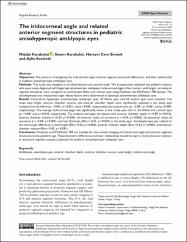The iridocorneal angle and related anterior segment structures in pediatric anisohyperopic amblyopic eyes
Künye
1.Karabulut M, Karabulut S, Simsek HC, Karalezli A. The iridocorneal angle and related anterior segment structures in pediatric anisohyperopic amblyopic eyes. SAGE Open Medicine. January 2022. doi:10.1177/20503121221107474Özet
Objectives: We aimed at investigating the iridocorneal angle, anterior segment structural differences, and their relationship in pediatric anisohyperopic amblyopic eyes.
Methods: This study was designed as an observational case-control study. We prospectively evaluated the pediatric patients who were newly diagnosed with hyperopic anisometropic amblyopia. Iridocorrneal angle in four sectors, axial length, and anterior segment structures were compared to emmetropic fellow and control eyes using Pentacam and IOLMaster 700 devices. The anisohyperopia and iridocorneal angle related factors were determined in hyperopic anisometropic amblyopic eyes.
Results: Forty-three hyperopic anisometropic amblyopic eyes, 43 fellow eyes, and 44 control eyes were included. The mean axial length, anterior chamber volume, and anterior chamber depth were significantly reduced in the study eyes compared to the fellow (p < 0.001, p = 0.021, and p = 0.045, respectively) and control eyes (p < 0.001, p = 0.001, and p = 0.009, respectively). The average iridocorneal angle was significantly lower in the study eyes than in the fellow and control eyes (p < 0.001 and p = 0.018, respectively). The iridocorneal angle correlated with anterior chamber depth (r = 0.49, p = 0.013), anterior chamber volume (r = 0.42, p = 0.038), the anterior radius of curvature (r =-0.54, p = 0.005), the posterior radius of curvature (r =-0.58, p = 0.002), and lens thickness (Rho =-0.41, p = 0.033) in the study eyes. Anisohyperopia was related to the interocular difference in axial length (Rho = 0.53, p = 0.005), anterior chamber depth (Rho = 0.53, p = 0.005), and anterior chamber volume (Rho = 0.42, p = 0.031).
Conclusion: Pentacam and IOLMaster 700 are suitable for non-contact imaging of iridocorneal angle and anterior segment structures in the pediatric age. These biometric differences and their relationship should be kept in mind whenever anterior or posterior segment surgery is planned for pediatric anisohyperopic amblyopic eyes.


















